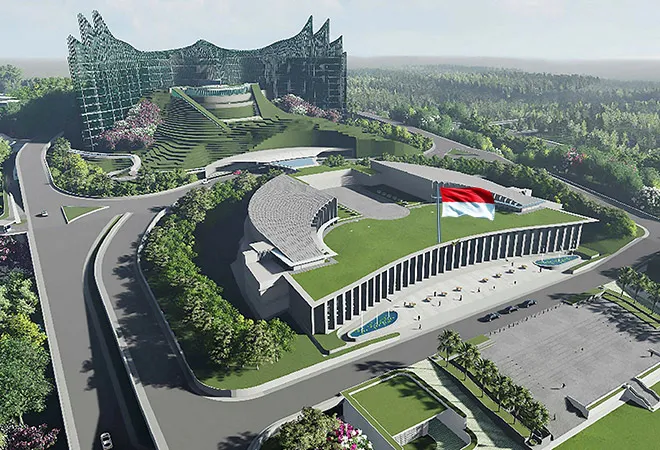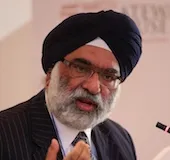
ASEAN’s largest country, Indonesia, plans to shift its capital from Jakarta to a new city, Nusantara, which is 2,000 kilometres away from the former. Jakarta is an old Javanese city, developed during the Dutch period whereas Nusantara will be a greenfield city. The shift will be from Indonesia's most populated Java to a sparsely populated Kalimantan island in Borneo. Redistribution of regional concentration, equitable wealth creation opportunities, and the challenges of climate change are the reasons stated for relocation.
On 18 January 2022, a law for the National Capital City (RUU IKN) and shifting the capital was approved in the Parliament. Construction may officially begin this year. The previous
day, President Jokowi told a university that ‘The new capital city will be built as a new locomotive for the transformation towards an Indonesia based on innovation, technology, and a green economy.’
Jokowi’s sway over the Parliament continues to remain strong as he still has the backing of eight parties. The Prosperous Justice Party (PKS), was the only party that opposed the law.
The Balinese sculptor Nyoman Nuarta famed for his Garuda Wisnu Kencana (GWK) statue in Bali, is tasked with designing the new presidential complex.
President Jokowi announced the new capital in 2019 as he began his second term. It will be built across the North Penajam Paser and Kutai Kartanegara regencies in East Kalimantan. This lies between Balikpapan and Samarinda, two large cities. It is near the coast of the Makassar Sea across from the Sulawesi islands. The
Balinese sculptor Nyoman Nuarta famed for his Garuda Wisnu Kencana (GWK) statue in Bali, is tasked with designing the new presidential complex. The IKN Nusantara Special Regional Government, the State Capital Authority, will administer Nusantara. Its members will be presidential appointees for a term of five years and will not be elected.
The pandemic delayed the shifting which is now expected to be finished by 2024, when Jokowi’s presidency comes to an end. His infrastructure push for Indonesia with reduction in regional imbalance may leave Nusantara as a legacy.
Jakarta, the largest ASEAN city of 10 million inhabitants, would remain the economic centre. Amongst the primary reasons for the shift are challenges emerging from climate change. Jakarta, at sea level, often faces massive flooding which even impedes Central Jakarta. Low-lying districts suffer consistently. Increased construction activity generates risks of enhanced flooding. North Jakarta is reportedly drowning, sinking 25 centimeters annually. The extraction of drinking water from aquifers is getting shallower.
Jakarta’s satellite towns of
Bogor,
Depok,
Tangerang, and
Bekasi, is growing rapidly to 10,000 square kilometres and 35 million people. It’s the world’s second largest urban area after Tokyo.
Jakarta, the largest ASEAN city of 10 million inhabitants, would remain the economic centre. Amongst the primary reasons for the shift are challenges emerging from climate change.
The redistribution of wealth, has been a goal for Jokowi and the ruling People's Democratic Party of struggle. Java traditionally dominated Indonesia and has 60 percent of the country's 300 million populace. Java almost always held the seat of political power. Relocating to Kalimantan across the Java Sea is rebalancing the power equation.
Half of Indonesia's GDP emerges from Java. Kalimantan is four times larger in size. Jakarta and Java are steeped in history, culture, and tradition with various kingdoms born there, which created cultural edifices. Kalimantan is a remote, large, and sparsely populated area which has never been in the forefront of political activity. It is known as the land of fortune as opportunities for coal mining, palm oil plantations, and large tracts for cash crops are available there. It is also known for its orangutan sanctuaries and rain forests. However, in recent years, it has been noted for environmental concerns such as the degradation of the rain forests for the production of palm oil and frequent forest fires.
Emerging criticisms
Indonesia is not the first ASEAN country to shift from an overpopulated capital. Malaysia created a government city in Putrajaya, 34 kilometre from Kuala Lumpur in 2003. This was the ‘adjoining-government-city’ model. Myanmar shifted its government to Naypyidaw from Yangon in 2006. There the capital moved far away, to avoid security
and other challenges.
However,
moving the capital is never an easy task. Alternate views and criticisms of the plan abound. President Sukarno (1945-1967) planned to relocate the capital to Palankaraya in Central Kalimantan but his plan did not reach fruition. President Yudhoyono (2004 to 2014) also thought about it, but the cost of building a new capital is daunting. The choices between expenditure on pressing matters and a new capital, perhaps, restrained him.
Alternate views and criticisms of the plan abound. President Sukarno (1945-1967) planned to relocate the capital to Palankaraya in Central Kalimantan but his plan did not reach fruition.
When Jokowi announced the project in 2019, the government said 19 percent of the estimated cost of 466 trillion rupiah (US $32.5 billion) would be from the national budget. The government was optimistic to attract private investment, including through public-private partnerships. But this estimation was based on pre-pandemic times. Now the appetite for such large projects may have diminished; however, the ardour in the Presidential Place has not.
The Finance Minister Sri Mulyani emphasised the relocation will be staged, in five stages up to 2045. The near-term focus is on infrastructure work. The administration is constructing a dam, water system, and roads near the planned “nodal central government area,” of about 6,600 hectares, or 2.5 percent of Nusantara's total planned area of 256,000 hectares.
There are unconfirmed expectations that investments will come from the
UAE, Europe, China, Korea, and Japan. This remains uncertain.
While 19 percent may come from state coffers, most will be funded by state-owned enterprises. This model is consistently used in recent years for infrastructure development alongside Chinese support.
Another criticism of the relocation plan is the potential forced removal of the indigenous Paser-Balik people from their lands, forest clearance, and threats to local flora and fauna including endangered orangutans.
Amongst the critics is an Indonesian geologist who says that though a smart city is planned but the planning is imperfect. According to him, there will be a water shortage around Nusantara as groundwater lacks easy access. The rivers get a draft from the strong sea tides, making them brackish. The cost of water reservoirs in the region is likely to high.
He avers that construction will become costly because the sedimentation requires deep foundations to be built as the ground is not strong. Thirdly, there are no primary forests left in the region of Nusantara. During the rains, there is no natural hold on the flow of water, therefore inundating the region. Fourthly, the region is full of coal deposits. If the frequent forest fires reach the shallow coal streams, then they will end up generating smoke and cause air pollution.
Jokowi surprised many with his intention to start the relocation. Besides the scientific reasons given, it is whispered that the 2016 takeover of central Jakarta by radical Muslim youth left the city defenseless.
Ultimately, Jokowi assuaged the demonstrators by praying with them in the open. The desire to be in a secure, distant, less populated capital, perhaps stems from that experience.
The government, including the Foreign Ministry, is in the lead to shift. This causes anxiety amongst several embassies which, in the last five years built new, secure premises. India, too, is now ready to redevelop its old embassy but may have to stall the project.
The ASEAN secretariat in Jakarta received a new building gifted by Indonesia in 2019. It may not have to shift as it is a regional organisation.
The shift to Nusantara should be seen in the context of the maritime fulcrum project that was proposed during Jokowi’s first term, with the intention to create infrastructure in all regions of Indonesia for rebalancing purposes.
In other cases, where new capitals were far way, embassies first moved an office to keep up liaison in the new capital. They only move when schools, hospitals and other infrastructure are ready. The planning on this seems unclear.
Such a shift raises several questions. Is the shift to Nusantara an effort to Javanise Kalimantan? Is it a short-term measure to create a Jokowi legacy before his term ends? Is it to create an advantage for enterprises and supporters who may have acquired land in advance of the announcement? Or is it a long-term measure to rebalance the power equations in Indonesia?
The shift to Nusantara should be seen in the context of the maritime fulcrum project that was proposed during Jokowi’s first term, with the intention to create infrastructure in all regions of Indonesia for rebalancing purposes. Moreover, well before its independence, a new language, Bahasa Indonesia, was created, replacing the dominant Javanese. This created a unified country with cultural diversity. It is highly unlikely that Indonesia would give up that effort by allowing Java’s influence to overwhelm Kalimantan.
A benign outlook towards a promising legacy, with a smart new development can be anticipated. Such a substantial shift will be accompanied by implementation hurdles. Nevertheless, Indonesia will benefit from a smart move to a smart Nusantara in the long term.
The views expressed above belong to the author(s). ORF research and analyses now available on Telegram! Click here to access our curated content — blogs, longforms and interviews.



 ASEAN’s largest country, Indonesia, plans to shift its capital from Jakarta to a new city, Nusantara, which is 2,000 kilometres away from the former. Jakarta is an old Javanese city, developed during the Dutch period whereas Nusantara will be a greenfield city. The shift will be from Indonesia's most populated Java to a sparsely populated Kalimantan island in Borneo. Redistribution of regional concentration, equitable wealth creation opportunities, and the challenges of climate change are the reasons stated for relocation.
ASEAN’s largest country, Indonesia, plans to shift its capital from Jakarta to a new city, Nusantara, which is 2,000 kilometres away from the former. Jakarta is an old Javanese city, developed during the Dutch period whereas Nusantara will be a greenfield city. The shift will be from Indonesia's most populated Java to a sparsely populated Kalimantan island in Borneo. Redistribution of regional concentration, equitable wealth creation opportunities, and the challenges of climate change are the reasons stated for relocation.
 PREV
PREV


